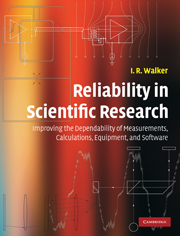 Reliability in Scientific Research
Reliability in Scientific Research Published online by Cambridge University Press: 05 June 2012
Most scientists who spend a significant amount of time in the laboratory are only too well aware of the amount of lost time, wasted resources, and diminished morale that result from unexpected problems that inevitably arise in research. These reliability problems include things such as sudden leaks in vacuum systems, vibrations in sensitive optics, and bugs in computer software. The purpose of this book is to help those working in the physical sciences and engineering to:
identify potential sources of unexpected problems in their work,
reduce the likelihood of such problems, and
detect and eliminate them if they occur.
Most of the problems discussed herein concern technical matters, as in the above examples. However, a significant part of the book is devoted to human errors and biases, and other similar issues.
In modern research it is common practice to employ a variety of different experimental methods, often in combination. Some – such as electronics, computing, vacuum, and optics – can be considered “core techniques,” which are widely used in many areas in the physical sciences and engineering. These are a major focus of this book. There are numerous specialized techniques used in particular research fields that can be sources of problems, but which cannot be included in a work of this size.
If one aims to cover a large range of subjects in a single volume, the depth at which they can be treated is necessarily limited.
To save this book to your Kindle, first ensure [email protected] is added to your Approved Personal Document E-mail List under your Personal Document Settings on the Manage Your Content and Devices page of your Amazon account. Then enter the ‘name’ part of your Kindle email address below. Find out more about saving to your Kindle.
Note you can select to save to either the @free.kindle.com or @kindle.com variations. ‘@free.kindle.com’ emails are free but can only be saved to your device when it is connected to wi-fi. ‘@kindle.com’ emails can be delivered even when you are not connected to wi-fi, but note that service fees apply.
Find out more about the Kindle Personal Document Service.
To save content items to your account, please confirm that you agree to abide by our usage policies. If this is the first time you use this feature, you will be asked to authorise Cambridge Core to connect with your account. Find out more about saving content to Dropbox.
To save content items to your account, please confirm that you agree to abide by our usage policies. If this is the first time you use this feature, you will be asked to authorise Cambridge Core to connect with your account. Find out more about saving content to Google Drive.